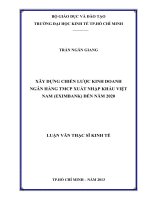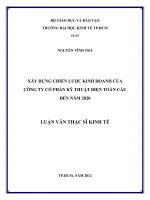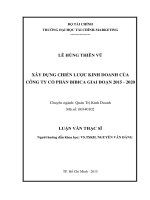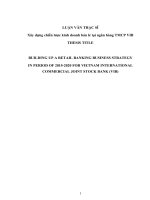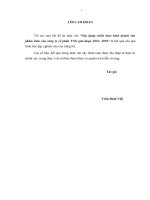Luận văn thạc sĩ xây dựng chiến lược kinh doanh bán lẻ tại ngân hàng TMCP VIB
Bạn đang xem bản rút gọn của tài liệu. Xem và tải ngay bản đầy đủ của tài liệu tại đây (1.27 MB, 96 trang )
LUẬN VĂN THẠC SĨ
Xây dựng chiến lược kinh doanh bán lẻ tại ngân hàng TMCP VIB
THESIS TITLE
BUILDING UP A RETAIL BANKING BUSINESS STRATEGY
IN PERIOD OF 2015-2020 FOR VIETNAM INTERNATIONAL
COMMERCIAL JOINT STOCK BANK (VIB)
1
TABLE OF CONTENTS
Acknowledgements …………………………………………………………………
i
Table of Contents ……………………………………………………………………
ii
List of Tables ………………………………………………………………………..
iii
List of Figures & Graphs ……………………………………………………………
iv
PREFACES
………………………………………………………………………….1
Chapter
1
–
Literature
review
on
business
strategy
……………………………... 5
1.1 Concepts and role of corporate business strategy ......................................
5
1.1.1 Some concepts on business strategy …………………………..
5
1.1.2 Roles of business strategy …………………………………….
7
1.1.3 Business strategy models ……………………………………..
8
1.1.3.1Linear strategy model …………………………………
8
1.1.3.2 Adaptive strategy model ……………………………..
9
2
1.1.3.3 Interpretive strategy model …………………………..
9
1.2 Formulation process of comprehensive business strategy ……………..
10
1.2.1 Selection
of
corporate
mission
and
objectives
……………….11
1.2.1.1Mission
……………………………………………….11
1.2.1.2
Vision
………………………………………………..11
1.2.1.3 The business objectives ……………………………..
11
1.2.2 The external environment analysis and evaluation …………..
12
1.2.3 The internal environment analysis ……………………………
12
1.2.4 Selection of business strategy ………………………………...
13
1.2.5 Strategy implementation ………………………………………
15
Chapter 2 – Analyzing the current retail banking services in Vietnam
International Joint Stock Bank (VIB) …………………………….
16
2.1 Overview on Vietnam International Bank ………………………………
16
3
2.1.1 General introduction, mission and commitment of VIB ……...
16
2.1.2 Highlights in the history of development ……………………..
18
2.2 Analysis of impacts of business environment at all levels ……………...
19
2.2.1 International financial – monetary crisis & world economic
recession ………………………………………………………………..
19
2.2.2 Economy of Vietnam ……………………………………………...
20
2.2.3 Environment for activities of Vietnam banking sector ……………..
25
2.2.3.1 Context and activity trends of Vietnam banking sector …....
25
2.2.3.2 Structure and size of Vietnam banking industry …………..
28
2.2.3.3 Rivalry evaluation in Vietnam banking industry ………….
30
2.2.4
Overview
on
the
Vietnam
retail
banking
market
…………………...35
2.3 Opportunities and Threats for Vietnam retail banking operation ……………..
39
2.3.1 Opportunities of the retail banking operation ……………………...
39
4
2.3.2 Threats of the industry ……………………………………………
42
2.4 Internal analysis of Vietnam International Bank (VIB) ……………………...
43
2.4.1 Structure organization, products and operations of VIB …………...
43
2.4.1.1 Structure organization …………………………………....
43
2.4.1.2 VIB’s products and services ……………………………..
44
2.4.1.3 Performance of VIB in retailing bank services …………...
45
2.4.2 Strengths of VIB ………………………………………………... ...
48
2.4.2.1 Regarding Core-banking technology …………………....
…48
2.4.2.2 Regarding customer services quality and policy ………...
…48
2.4.2.3 Regarding financial resources …………………………..
…49
2.4.2.4 Regarding operation network ………………………….. …
49
2.4.2.5 Regarding organization and personnel structure ……….. …
50
2.4.2.6 Regarding operation management ……………………. . …
50
5
2.4.2.7 Regarding image and trademark ………………………. …
51
2.4.2.8 Regarding quantity of customers …………………………
51
2.4.3 Weaknesses of VIB ……………………………………………….
52
2.4.3.1 Regarding VIB’s position in Vietnam Commercial Joint
Stock
bank
system
…………………………………………………. …52
2.4.3.2 Regarding trademark image ………………………….
….53
2.4.3.3
Regarding
the
financial
scale
……………………………..54
2.4.3.4 Regarding business performance …………………………
54
2.4.3.5 Regarding operation management ………………………..
55
2.4.3.6
Regarding
organization
structure
…………………….........56
2.4.3.7
Regarding
product
development
………………………......56
2.5
Conclusion
………………………………………………………………......57
Chapter 3 – Building up a retailing business strategy for VIB in the period of 2010
– 2013 - Solutions and Performance Schedule ………………………………...
58
6
3.1 Strategy selection …………………………………………………………..
58
3.2 Strategic contents …………………………………………………………..
63
3.2.1 Overview of VIB’s strategy objectives …………………………...
63
3.2.2 Specific plan for VIB retail banking services to 2013 ……………. 64
3.2.2.1 Business objectives of retail banking in each period …… 64
3.2.2.2 The strategy orientation and operation methods ……….. 64
3.3 Strategy implementation solutions ……………………………………….. 65
3.3.1 Customer orientation …………………………………………… 65
3.3.1.1 Determining the target customers ……………………... 65
3.3.1.2 Organization model re-structure on the direction of customer
– centered ………………………………………………………
69
3.3.2 Product and Price Development …………………………………73
3.3.2.1 Products ……………………………………………….73
3.3.2.2 Product’s price ………………………………………... 74
3.3.3 Distribution channels …………………………………………... 75
3.3.4 Marketing and Trademark ……………………………………... 77
3.4 Implementation roadmap ………………………………………………... 80
3.4.1 Implementation schedule ……………………………………….. 80
3.4.2 Implementation when converting the structure of branch model …81
7
3.4.2.1 Setting up a project team on new business strategy model
conversion …………………………………………………….81
3.4.2.2 Communication ……………………………………… 82
3.4.2.3 Problems on human resource investment training …….. 82
CONCLUSION ……………………………………………………………………...84
REFERENCES ……………………………………………………………………...87
LIST OF FIGURES
No
Figure No.
Figure’s Name
1
1.1
Strategy Types
2
1.2
Strategy Implementation
4
3.1
VIB’s Retail Bank Region
5
3.2
VIB Business Units
6
3.3
Project team on new business strategy model
LIST OF GRAPHS
No.
Graph No
Graph’s Name
1
2.1
Vietnam Retail Banking market
2
2.2
Customer rate of banking service
3
2.3
Loan Expansive level
4
2.4
Vietnam Commercial Joint Stock Bank as per total assets
2008
LIST OF TABLES
No Table. No
1
1.1
Table’s Name
SWOT Matrix
8
2
2.1
Forecast on Vietnam basic economic indicator in 2010 – 2013
3
2.2
Number of banks in the period of 1997 – 2007
4
2.3
Data on growth criteria of Vietnam banking industry 200 - 2007
5
2.4
Loan market share in the period of 2000 – 2007
6
2.5
Mobilization market share in period of 2000 – 2007
7
2.6
Performance of retailing business of VIB
8
3.1
VIB’s SWOT Matrix
9
3.2
Business objective of retail banking in each period
10
3.3
Distribution Channels of VIB
9
PREFACES
Nowadays, the international economic integration is indispensable trend in
developing countries. For Vietnam, the international integration is a proper and
significant direction, acting as a premise for constructing the position in the
international arena and bringing series of opportunities to the prompt and
sustainable development for the national economy.
However, the integration also gives out big threats to Vietnamese
enterprises; especially the commercial banks – the special enterprises operating in
monetary- credit fields. To conquer the threats and optimizing good opportunities,
Vietnam Commercial Banks are required to select a sound direction, applying a
sensible and timely business strategy.
The banking integration requires Vietnamese Commercial Banks to
promptly launch their coverage
development, technical investment and
management improvement. Modern technology, management competence and
abundant financial potential of overseas banks will be the basic advantages,
creating competition in the banking industry resulting in the Vietnamese banks’
capital increase, technical investment, management reform and modernization of
the payment system to improve performance and competitiveness.
It is possible to say that in such a cut- throat competition and difficult
context as present, any banks who take a proper strategy, optimize opportunities
and well match with the threats will be the winner and their position in the world
financial banking market will be stable.
The availability of commercial banks in most of the socio- economic
activities proves a fact that “where a commercial bank system develops, there
obtains high development of the socio-economy and vice versa”. With response to
the urgent issue of having a strategy to develop the commercial banks
synchronously and effectively, making contribution to the national economic
development in the trend of international economic integration, majority of group
10
members are working in the financial- banking industry, being one of the
managerial staffs of VIB, we decide to select and make a research on:
“BUILDING UP A RETAIL BANKING BUSINESS STRATEGY
IN PERIOD OF 2009 - 2013 - FOR VIETNAM INTERNATIONAL
COMMERCIAL JOINT STOCK BANK (VIB)”
1. Subjects of the study:
The global financial crisis and economic depression including Vietnam lays
enterprises in a new period where they request to activate a more professional,
better management style and take a more prudent orientation strategy. Besides,
involvement of many domestic and international credit institutions into the
financial- banking market with diversified products and services in the past time
makes the domestic banks to take a proper strategy to adapt and develop in a high
competitive market.
In such context, Vietnam International Commercial Joint Stock Bank, a
member operating in Vietnam banking association, has prepared for the next
development in all fields. VIB Bank carries out a significant program to modernize
comprehensively the consumption network, effectively supported by the
professional and dedicated staff to create strengths to the bank with commitment on
service quality assurance. VIB Bank trademark is expected to be worthy with a title
of “dedicated bank”.
According to the domestic and international experts “Vietnam retail market
is extremely attractive”. Therefore, objectives of the commercial joint stock banks
in general and VIB Bank in particular are “How to provide the best retail banking
services”. By investigating the overview of retail bank service, achievements and
restrictions of Vietnam commercial joint stock banks in general and VIB Bank in
particular, subject of the thesis is to investigating the operations as well as strategy
for developing retail banking products of VIB Bank.
11
2. Scope and objectives of the study:
The thesis analyzes the retail banking situation in VIB Bank through factors
such as strategy, trademark, product, personnel organization structure, finance and
technology, and so forth. Thence, it is expected to identify strength and weakness
of VIB Bank. Thanks to analysis on the international business environment, the
external socio- economic and politic environment, VIB Bank can sketch their retail
banking operations as well as solution to implement such strategy in the most
effective manner.
Through SWOT matrix model, our group confirms that SO strategy is the
optimal strategy for retail banking operation of VIB Bank. What are objectives of
the strategy? What are the contents of the strategy? Which solutions set out for the
strategy formulation? These questions will be answered in this thesis.
3. Research methodology
The main research methodology of the thesis is to apply theoretical model
on strategy management in an enterprise to employ in a specific condition of VIB
Bank to plan a master business strategy.
The secondary data collection method is mainly applied in the thesis
including:
- Internal data of VIB Bank
- External data collected from the State Bank of Vietnam, Bank Association,
Financial Statement, and Annual Reports of some commercial banks in Vietnam
- Sources from newspaper, internet.
- Some references, home and abroad lecture materials on strategy
management module.
Besides, the group also uses some sampling statistics method, survey,
questionnaire and analysis.
12
4. Design of the study:
Excluding the prefaces and conclusion, the study includes 03 main parts:
Chapter I: Literature review on business strategy
Chapter II: Analyzing the current retail banking services in Vietnam
International Commercial Joint Stock Bank (VIB)
Chapter III: Building up a retail banking business strategy of VIB in period
of 2009 - 2013 - Solutions and performance schedule
13
CHAPTER I
LITERATURE REVIEW ON BUSINESS STRATEGY
1.1 Concepts and role of corporate business strategy
1.1.1 Some concepts on business strategy
Accessing to the 21st Century, the world witnessed the impressive starts with
significant innovation in the global business environment such as new technology
launch, increasingly strict quality control regulations, unexpected environmental
fluctuation and so forth. Corporate operation must associate with panorama of the
world economics, the regional and international integration by searching and
developing comparative advantages to be the winner in the increasingly severe
competition in the nation and the world. In such content, each company has their
own new opportunities to exploit and threats to be prevented and restricted.
Therefore, in order to adapt with high performance business environment,
enterprises in general and Vietnamese enterprises in particular must have the
strategic thinking, i.e. long- term vision to ensure the corporate existence and
development.
“Strategy” term is derived from the military. In the strategic military, it is
interpreted as an art of cooperating mobilized military, political, spiritual and
economic forces to win the enemy. However, the term is widely used in many
business fields.
Although the business strategy term appeared for a long time, there is no
exact and complete concept about this. Michach Mporter – Professor of Harvard
university revealed that: “Business strategy is an art of forming the competitive
advantages”. Therefore, business strategy is one of competition instrument among
companies. It is a measure for companies to achieve their set targets by
constructing the competitive advantages or strengths, opportunities, risks,
14
challenges, etc, thence, working out proper solutions to keep the dominant position
in business.
According to consulting group of Boston Consulting Group (BCG):
“Business strategy is an allocation of available resources to change the balance of
corporate available resources and convert the competitive advantage toward their
company”. That means by analyzing their resources, corporate departments and
allocating resources optimally, effective solutions have been worked out to achieve
the set targets with highest performance to create the competitive advantage.
Alain Charles Martinet described “Strategy is an art which companies apply
to compete and win”. Like this, strategy is used to sketch sustainable and longterm development orbit. Corporate exact decisions and actions can be arranged
surrounding such orbit.
In business environment, “strategy” term is almost derived from basic laws.
However, the term application is often failed due to poor understanding on nature
and how to use this term. Therefore, it is very difficult to obtain a consistent
definition on strategy because of 2 basic reasons: (1) strategy includes various
fields, and (2) individual strategy, it changes as per case of company in each
specific industry. There are at least three strategy types in the business world
including Strategy or Traditional Strategy; Corporate Strategy and Competitive Strategy.
Figure 1.1
15
Although there are many definitions on strategy, it generally focuses on 4
main categories namely plan, model, position and prospect. In other words, strategy
is:
•
The destination which companies strive to obtain in a long term (orientation)
•
What market companies have to compete and which types of activities
companies take in such market (market, scale)?
•
How companies do to have better performance against rivals in such markets
(advantages)?
•
Which resources (skills, assets, finance, relations, engineering competence,
and equipment) need to be able to compete (resources)?
•
External factors affect the corporate competitiveness (environment)?
•
Which values and expectations that internal and external senior managers
need (capital contributors)?
1.1.2 Roles of business strategy
Business strategy of the companies is determined as the companies answer
the questions.
Enterprises:
+
Where are they?
+
What do they want to do?
+
What do they need to do?
+
What will they do?
+
How does it?
By determining where the companies stand, the formed business strategy
will give the answer about where the companies wish to reach and how they can
reach it. The business strategy describes corporate objectives and orientation for
high performance.
16
The strategy supports effectively companies applied it, creating an
advantage position in market, the strategy facilitates companies to find out their
strengths and weakness to develop or restrict, respectively. Thanks to strategy,
companies are always in the active position against the environment changes.
Nowadays, in the market economy with fierce competition of internal and
external rivals, companies must not only make great effort to perfect the internal
functions but also be dynamic and flexible in their operations in line with the
market’s complicated changes. This situation requires companies to have farsighted vision for their development. The strategy is a key to the success of
companies. Therefore, it is supposed to start a plan by giving out a future prospect
including the exact position and how to achieve it with a comprehensive and logical
plan. Decision and operation of the model mark the changes from the initial steps to
the success.
1.1.3 Business strategy models
1.1.3.1 Linear strategy model
The linear strategy model focuses on planning. It is called linear because it
encloses sequential, oriented and logical activities during planning.
In accordance with the linear point of view, the strategy includes an
integration of decisions, actions or plans set out and oriented toward the
organization’s objectives. Both objectives and way to achieve it are the results of
the strategic decision. In order to achieve the set target, the organization can modify
their affiliates with surrounding environment such as product modification, market
transition or application of other operations. Terms associated with the linear
strategy model include strategic planning, strategic system formation and strategy
performance.
The linear model describes senior manager as a person who can change the
organization structure. The surrounding environment is a combination of
difficulties set by rivals. Through making a logical decision, the senior manager
17
identifies objectives, works out alternative solutions to achieve the target, evaluates
success possibility of each solution and decides the implementation measures.
The linear model is increasingly less used because the strategic problems
become more complicated not only in terms of various management aspects but
also changes of variables of specifications, economic, information, society and so
forth.
1.1.3.2 Adaptive strategy model
It is defined that an adaptive strategy model concerns developing possibility
to combine opportunities and threats of business market with corporate resources
and capacity to exploit that opportunities.
Companies are forecasted to continue evaluating the internal and external
conditions. Evaluation results are the proper adjustment in the organization or in
relevant environments to create the logical combination between opportunities and
threats of environment and the corporate and resources.
Adaptive strategy is based on some hypothesizes. Companies and
environment have a closer relation compared with the linear model. However in the
adaptive model, environment is flexible and difficult to forecast. The business
environment encompasses rivals, trends and relevant partners (having increasingly
important role). In the linear model, companies must face with business
environment, whereas the adaptive model supposes that companies change as per
business environment.
The adaptive model uses many variables and has higher modification
possibility against the linear model. However, it is thought that the business world
is still much more complicated.
1.1.3.3 Interpretive strategy model
The interpretive strategy model is mainly based on the social relation
factors. The social relation views consider company as a combination of
18
cooperative commitments among individuals based on willingness. The corporate
existence depends on capacity of attracting sufficient human resources with proper
benefits for parties.
This model supposes that in fact, no objective or exogenous things are
available formed through a process of the social impacts in which feelings of each
person is reliable, adjustable and alternative as per feelings of other persons.
Strategy in the interpretive model can be identified as an oriented or guided
metaphor enabling the organization’s important elements to understand the
organization and the environment. Thanks to that, the important elements are
encouraged to be believed and performed to bring benefits to companies.
Like the adaptive strategy, the interpretive strategy supposes that companies
and business environment are closely related. However, in the adaptive strategy,
corporate leaders fix perspectives of individuals in the company as well as futurerelated individuals and products. However, the leaders do not carry out the physical
modification on products. Opinion change orients toward the higher reliability to
company or the company’s products. With that point, the interpretive strategy is
coincident with the adaptive strategy.
A distinctive feature between the adaptive model and the interpretive model
is approach of each model in terms of complexity. The adaptive strategy makes
great effort to settle a complicated problem regarding the structure, especially the
corporate product conflict and demand change. The interpretive strategy
emphasizes on attitude and awareness of corporate- related parties.
1.2 Formulation process of comprehensive business strategy
The comprehensive business strategy is constructed based on the corporate
vision and long-term strategic orientation for all operations of the company. It
includes:
1.2.1 Selection of the corporate main mission and objectives
19
The corporate main mission and objectives offer a context for strategy
formulation. The strategy describes existence reason of the company and what to
perform. Whereas, the objectives determine what the company expects to satisfy
within the medium and long term scope.
1.2.1.1 Mission
Mission refers to a message embodying the corporate core value. It
represents what important and contribution of company in terms of business and
life, the corporate business principle, corporate position in the world and
commitments which the company will comply with.
The mission should be concise and comprehensive in terms of fundamental
meaning but it also embodies encouragement and long term stability.
1.2.1.2 Vision
Vision refers to a message specifying the Mission into an encouraging
target. It describes necessity of the survival improvements for the corporate,
creating the corporate future confidence and orienting to make the impossibility
become possibility.
1.2.1.3 The business objectives
Objectives are set by developing the company’s mission, but more separate
and specific. Objectives can be set for long term or middle and short term.
Long term objectives can be: profitable capability, productivity, competitive
position, staff development, technology leader, or social responsibility, etc…
Middle and short term objectives (under 1 year) are clearly and time limited.
Short term objectives are required to be detailed, measurable, reality, and utmost
important are aimed to realize the long-term objectives.
1.2.2 The external environment analysis and evaluation
20
The external environment analysis aims at
acknowledging the corporate opportunities and threats
from the external environment. Three external
environment types which are closely interrelated
include macro environment, national environment and
the on-going industry environment.
The opportunities and threats are identified by
data analysis on changes in the on-going industry environment or the environment
to be penetrated. The opportunities can be market development potential, market
gap, close position to the material sources or inexpensive and qualified human
resources. The corporate threats can be the narrow market, increasingly fierce
competition, possible amendment on policies, political instability in the key
markets or new technology development resulting in the corporate facilities and
production lines are on the risk of being backward.
1.2.3 The internal environment analysis
Aims of the internal environment analysis are to find out the corporate
strengths and weakness.
By analyzing the internal environment, strengths on corporate organization
can be skills, resources and advantages which the enterprise obtains prior to other
rivals (the corporate key competence) such as having many talent managers,
outstanding technology, well-known trademark, cash availability, good image in
the public or large market share in the main markets. The weakness reveals in the
disadvantages or shortcomings of the enterprises. These can be the poor
distribution
network,
poor
labor
relationship,
mismanagement
with
the
international experience or backward products or services against rivals, etc.
The results of the internal and external environment analysis are the
comprehensive outcomes of the business environment study and evaluation. It
includes the business environment in a geological limit (politics, society,
21
economics, environment, and culture), the industry trends (science and technology,
technology, supply sources, etc); market situation (demand, consumption, trend
forecast); competition situation (main rivals, potential rivals, capacity, strengths
and weakness, forte and foible, current position and on-going strategy).
1.2.4 Selection of business strategy
The corporate business strategy refers to the development orientation and
construction of the competitive advantages based on understanding and situation
analysis implemented in the above steps. The enterprise can select strategy such as
under the 3 strategy groups as:
•
The Cost domination strategy (lowest price)
•
Concentrative strategy (Only focusing on a certain market
segment or a market; or Only focusing on a certain product group.)
•
Distinctive strategy.
The strategy selection can be carried out by SWOT based analysis method:
SWOT - based analysis approach
SWOT analysis mainly aims at identifying strategies which are oriented,
suitable or corresponding between the corporate resources and capacity with the
environment demand where the enterprise is operating.
SWOT Matrix
Opportunities (O)
Threats (T)
Strengths (S)
Combination
Combination (S/T)
(S/O)
Weakness (W)
Combination
Combination
(W/O)
(W/T)
22
Table 1.1 SWOT Matrix
SO combination strategy is obtained due to main strengths and opportunities
of the enterprise. It is important that the enterprise must develop their strengths to
maximize opportunities.
ST combination strategy is obtained due to main strengths and threats of the
enterprise. Here, the enterprise must develop their strengths to conquer the threats.
OW combination strategy is obtained because the enterprise maximizes
opportunities to overcome the weakness.
WT combination strategy is obtained because the enterprise strives to
mitigate weakness to avoid threats.
1.2.5 Strategy implementation
Company’s mission, vision and objectives (1)
Strategy implementation is an action plan to deploy all activities that the
enterprise will carry out together with achievements by the milestones it needs to
achieve the
general
goals. The plan also includes aBusiness
proper organization
Environment structure
Internal
Analysis
Analysis
(O, T) (2)
(S, W) to
(3)put the strategy into practice. The following
and control system
diagram can
illustrate procedure of business planning mentioned above:
Select and build up business strategy (4)
Company Strategy (5)
Functional and fundamental business strategy
Business Strategy Operating Schedule (6)
Operation Control and Evaluation (7)
23
Feedback
Figure 1.2
CHAPTER II
ANALYZING THE CURRENT RETAIL BANKING SERVICES
IN VIETNAM INTERNATIONAL JOINT STOCK BANK (VIB)
2.1
Overview on Vietnam International Commercial Joint Stock Bank
2.1.1 General introduction, mission and objectives of Vietnam
International Bank (VIB)
24
Vietnam International Joint Stock Company (abbreviated name is Vietnam
International Bank - VIB) has the head office in No. 198B Tay Son street, Dong Da
district, Hanoi; incorporated in accordance with Decision No.22/QD/NH5 dated
25th January, 1996 of the Governor of the State Bank of Vietnam. Founder
shareholders of VIB include Vietcombank, Agribank, successful individuals and
businessmen in the home and abroad.
Over 13 years of establishment and operated on 18th September, 1996, VIB
increasingly develops and affirms its position in the home financial market. With
initial charter capital of 50 billion VND, up to now its charter capital increases in
2,400 billion VND with total assets of more than 50 thousand of billion VND. VIB
is ranked on the first by the State Bank of Vietnam in accordance with the Vietnam
banking system rating standards in many successive years.
During its operations, VIB takes the business strategy modifications in line
with the domestic and international environment. Especially in period from 2004 to
2008, VIB sucessfuly deployed its business strategy with motto of “always offer
added value to customers”.
Vision: “Vietnam International Bank (VIBank) becomes the most creative
and customer-based commercial bank in Vietnam”
Mission:
For customer: Providing outstanding creative solutions to maximize
customer’s demand.
“We acknowlege that the satisfaction and success of customers is the key to
our sucess. We highly appreciated customers’ confidence. We are committed to
serving with convenient, quickly, confidentially, safely; diversified products with
competitive price”
For staff:
Building a effective corporate culture, business spirirt and
openness working environment.
25

